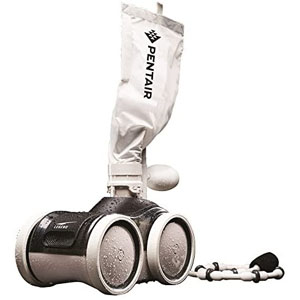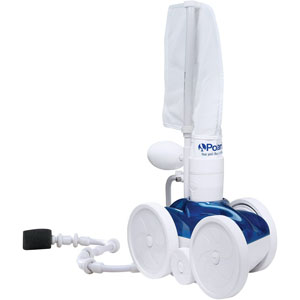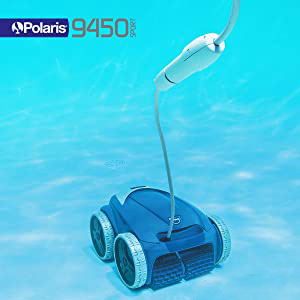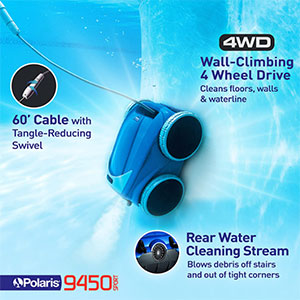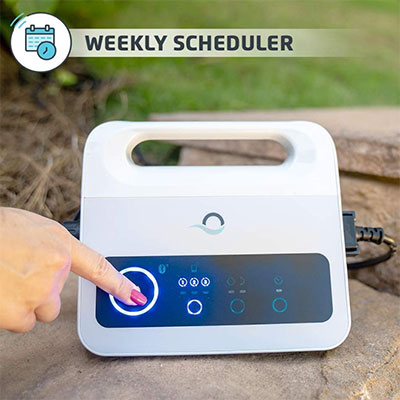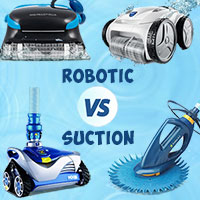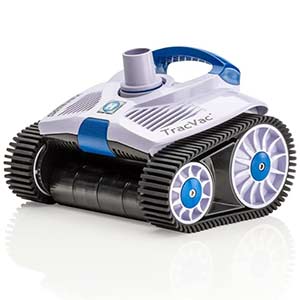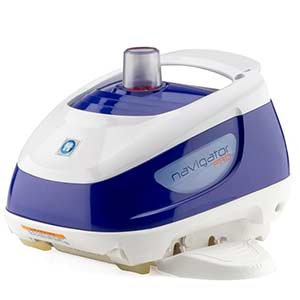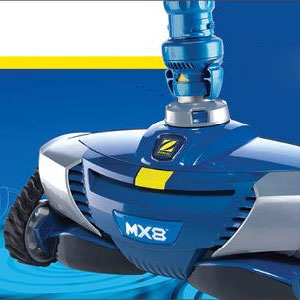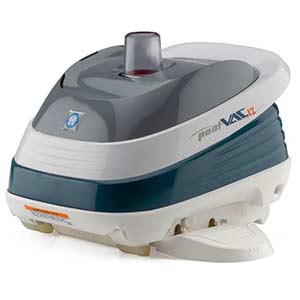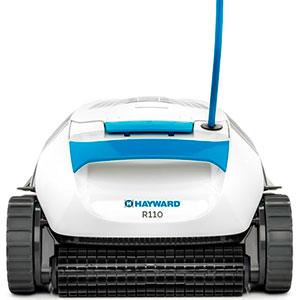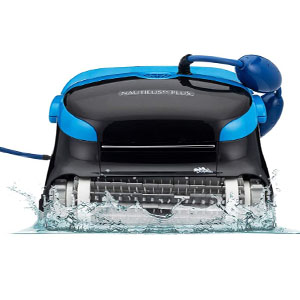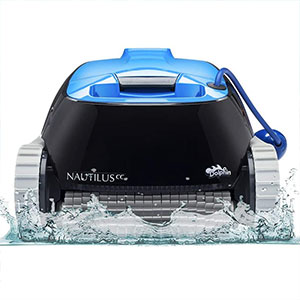Robotic vs. Pressure Side Pool Cleaners Comparison Review
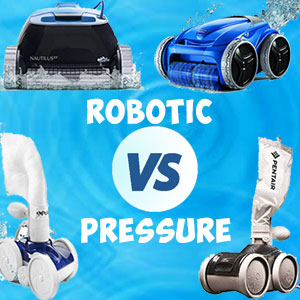
In this review, we want to determine whether robotic pool cleaners are a worthy update or if you’d rather stick with your pressure-side pool cleaner. Or maybe you want to know which way to go if you are a first-time pool owner. Either way, we will tell you the difference.
The main difference between robotic pool cleaners and suction-side pool cleaners is the fact that robotic pool cleaners work independently. In contrast, pressure side pool cleaners rely on a booster pump for operation. Besides, robotic pool cleaners offer better cleaning and convenience as they are packed with fancy features.
For details regarding how the two types of pool cleaners compare, keep it right here.
[wpsm_toplist]
| Parameter | Robotic Pool Cleaners | Pressure-Side Pool Cleaners |
|---|---|---|
| Price | Very Expensive | Cheaper |
| Assembly / Installation | Not Required | Required |
| Orientation | Floor, Walls, Waterline | Floors, Walls |
| Smart Scheduling | Yes | No |
| Maneuverability | Excellent | Average |
| Smart Mapping | Yes | No |
| Cleaning Efficiency | Excellent | Excellent |
| Designed For | Inground Pools | Above and Inground Pools |
| Filters | Fine, Medium and Large Debris | Medium and Large Debris |
Robotic vs. Pressure Side Pool Cleaners
Robotic and pressure side pool cleaners are 2 of the 3 available automatic pool cleaners. The 3 are favored because they work automatically, so you don’t have to struggle with manual cleaning. You also get to save a lot of time.
We will focus on the robotic and pressure side models in this segment. Find out how they work, their features, pros, and cons, and of course, the best models on the market.
- Polaris Vac-Sweep 280 Pressure-Side In-Ground Pool Cleaner
- Pentair LL505G Kreepy Krauly Legend Pressure-Side Inground Pool Cleaner
You can also check out our robotic vs. suction side pool cleaners review.
What is a Robotic Pool Cleaner?
Robotic pool cleaners are automatic pool cleaners that feature advanced programming technologies and sophisticated navigation and maneuvering systems to clean pools.
Robotic pool cleaners are becoming popular by the day. Recent statistics show that the industry was valued at $750.50 Million in 2021 and is projected to grow at a CAGR of 14.10 %, blossoming into a $2,483.50 Million market in 2030.
How Do Robotic Pool Cleaners Work?
Now, how do robotic pool cleaners work, and what sets them apart from other automatic pool cleaners?
Robotic pool cleaners are self-contained models that work independently. They don’t rely on your existing pool infrastructure. Most of the robotic pool learners on the market are corded, meaning they are plugged into the mains, but others, for example, Aiper pool cleaners are cordless.
These automatic pool cleaners come with a maneuvering system like pressure and suction side cleaners but this time with intelligent navigation systems for smart mapping and, consequently, entire level coverage. In the same unit, they also pack electric motors for suction and propulsion, filtration systems, and brushes for maximum cleaning performance.
Advantages and Disadvantages of Robotic Pool Cleaners
Robotic pool cleaners have several advantages, but there are also disadvantages, as listed below.
- No assembly or installation required
- Convenient pool cleaning (programmability)
- Don’t rely on the suction or pressure system of your pool
- Cleans floors, walls, and the tile line
- Effective cleaning courtesy of active brushes
- Excellent maneuverability and navigation
- Smart cleaning modes and features
- Not designed to capture floating debris
- Reachability is limited by cable length (corded models)
- The fancy features translate to high price tags
- Not safe when left in the pool
Best Robotic Pool Cleaners
Now that you know how robotic pool cleaners work and their advantages and disadvantages, we want to share two of the best robotic pool cleaners on the market. Check out their features and the pros and cons of each model.
Polaris 9450 Sport Robotic Pool Cleaner
The Polaris 9450 is designed for inground pools of up to 50 ft and cleans the pool floor, walls, and waterline. On the downside, it can’t capture floating debris but is unforgiving on stains and fine to large debris. The 9450 Sport has a large 5L canister and a top-access filter cartridge that allows for easy emptying. While you will have to empty the bin manually, the maintenance costs are lower, and the dirt doesn’t overwhelm your pool’s filtration system.
- Cleans floors, walls, and waterline
- Max suction performance
- 2 Modes: Floor or Floor/Wall
- 7-day programmable timer
- Enhanced cleaning cycles (1.5 or 2.5 hours)
- Entire level cleaning
- One-Touch easy lift function
- Premium caddy included
- Not effective in cleaning walls and floor junctures
- Can’t capture floating debris
- No full canister indicator
- No mobile app or remote operation
So, how does the 9450 do the actual cleaning?
First, the robot has two clean modes: Floor or Floor/Wall. You can clean the floor only or the floor and walls. It does a good job scrubbing stains and algae on the pool floor, walls, and the water line.
One of the advantages of robotic pool cleaners is the scrubbing function. The Polaris Sport has a pleated scrubbing brush that eliminates stains and algae, leaving your pool surfaces sparkling clean. The robot also boasts Vortex Vacuum technology that delivers max suction power to capture all kinds of debris, from fine dirt such as sand and silt to large leaves and twigs.
The Polaris Sport is a smart robotic pool cleaner that integrates sophisticated hardware and ActivMotion Sensor technology, enabling the robot to map your pool floor and plan efficient cleaning paths. Notably, the robot covers the pool faster than your average cleaner and has a 1.5 hour cleaning cycle. You can also set the cleaning cycle to 2.5 hours.
Regarding maneuverability, it relies on a 4-Wheel Drive system that consists of Aqua-Trac tires. It enables the cleaner to go over debris and climb walls with agility. As for propulsion, there is a dual-drive motor with one driving the front wheels while the other pushes the rear wheel system.
Other cool features are a premium caddy for easy mobility, an Easy Lift System, and 7-day programmability so you can set it and forget.
DOLPHIN Nautilus CC Automatic Robotic Pool Cleaner
The Nautilus CC is available in two variants; one without a caddy and another one that includes a caddy. Both are designed for above and inground pools of up to 33 ft, courtesy of the 50ft cable. However, while the Polaris Sport cleans the floor, walls, and waterline, the Nautilus CC can handle the floor and walls only.
- For both above-ground and inground pools
- Cleans all pool surface types
- Entire level cleaning
- Highly energy efficient
- Come with tracks for better climbing
- Large capacity top load filter basket
- It comes with a caddy for easy transportation
- Weekly scheduler
- Cleans the pool floor and walls only
- No remote or app operation
- Doesn’t clean floating debris
- No enhanced cleaning cycles
- No full bag indicator
Dolphin Nautilus CC is an excellent pool cleaner despite being unable to clean the tile line. It has a super scrubbing system that is gentle on the pool surface and tough on stains. Like the Polaris, it also features super suction that ensures all debris are sucked into the large filter compartment.
Regarding the filter compartment, the Nautilus CC has a top-load filter basket for easy maintenance. Unfortunately, there is no full bin indicator.
When it comes to navigation, this is also a smart robotic pool cleaner that scans and maps your pool for efficient cleaning and obstacle avoidance. It does complete the job fast and efficiently using less energy. As a matter of fact, the Nautilus CC’s operation costs just 5 cents per hour. Unfortunately, there are no enhanced cleaning cycles. The standard cleaning cycle is 2 hours.
When it comes to maneuverability, the Nautilus CC is a little bit different from the Polaris. Yes, it comes with 4 wheels, but you will notice that there are also tracks. The advantage of tracks is agility, especially when climbing the sliding pool walls.
Other features include a quick water release that empties the water quickly so you won’t struggle to lift it from the pool. There’s also a Scheduler that lets you program the robot to clean all week long. You can set it to clean every day of the week, every other day of the week, or every 3rd day of the week.
What is a Pressure Side Pool Cleaner?
Pressure-side pool cleaners are among the most popular automatic cleaners in many pools. They have been around for decades and appeal to pool owners for their cleaning performance and affordability.
So far, so good, pressure side pool cleaners are more popular than robotic pool cleaners. You see, robotic pool cleaners were introduced earlier (1967), while pressure side pool cleaners came 5 years later. However, the high cost of robotic pool cleaners has made pressure side pool cleaners popular.
How Pressure Side Pool Cleaners Work
Now that you know how robotic pool cleaners work, it would also be interesting to grasp how pressure side pool cleaners get the job done.
Unlike robotic pool cleaners, pressure side pool cleaners don’t operate independently. As the name sounds, they rely on your pool’s main pump to produce the pressure required to propel it and suck up dirt. This is one of the shortcomings of pressure side pool cleaners compared to robotic pool cleaners. For the record, there are two types of pressure side pool cleaners. One variant requires a booster pump, while the other strictly works with the main circulation pump.
Pressure-side pool cleaners also have a maneuvering system but are less advanced than their robotic counterparts. There is no pool mapping system, so the cleaner might miss some spots in irregularly shaped or large pools. Regarding propulsion, when water gushes out of the pool cleaner, it creates a venturi effect which pushes the cleaner forward.
Advantages and Disadvantages of Pressure Side Pool Cleaners
Like robotic pool cleaners, pressure side pool cleaners also have advantages and some drawbacks as well.
- Cheaper than robotic pool cleaners
- Easy maintenance
- Doesn’t strain your pool’s filtration system
- Clean the floor, walls, and waterline
- Collects large debris effectively
- Suitable for most pool types
- Not effective for capturing small debris
- Limited scrubbing ability
- No programming, scheduling, or smart features
- Requires a separate booster pump
- Take a toll on your energy bills and dedicated filtration system
Best Pressure Side Pool Cleaners
We understand that pool owners have different tastes. If you think a pressure side pool cleaner will work best for you, below are two of our editors’ best picks. Check out the features of each, as well as the respective advantages and disadvantages.
Pentair LL505G Kreepy Krauly
The Kreepy Krauly is an inground pool cleaner that offers effortless cleaning and captures all kinds of debris, including large debris such as leaves and twigs. But one thing to note is that it doesn’t offer comprehensive cleaning as it only cleans the floor and walls. For the water line, you will have to figure out a solution.
- Works in inground pools of all types
- Best for picking up large debris
- Scrubs stains and algae
- Four-wheel design for better traction
- Easy maintenance
- Parts are readily available
- Cleans pools in less than 3 hours
- Requires a separate booster pump
- An extra booster pump means higher energy bills
- The price is on the higher side compared to the competition
The Kreepy Krauly is not an independent pool cleaner. It relies on pressure from a separate booster pump sold separately, so the initial costs of this pool cleaner are higher. The compatible booster pump is the 0.75HP variant.
One thing we like about the Kreepy Krauly is the large intake throttle that enables it to capture all kinds of large debris, from acorns and leaves to twigs. Interestingly, it can pick up floating debris but not satisfactorily.
When it comes to navigation, the Kreepy Krauly is not a smart robotic pool cleaner. It moves randomly and leverages backup valve forces to reverse when stuck. While it does a great job in small pools, it misses some spots in large irregular pools.
Regarding maneuvering, we like that Pentair designed it with a 4 wheel system that gives it better traction compared to the three wheels in most pressure side pool cleaners.
Unfortunately, the Kreepy Krauly lacks any bells and whistles. For example, there is no weekly scheduler or remote operation. But we are glad the cleaner can be left in the water, and it takes less than 3 hours to finish cleaning an average-sized pool.
Polaris Vac-Sweep 280
The Polaris 280 is another top-rated pressure-side pool cleaner. It offers the same cleaning performance as the Pentair Kreepy Krauly, but there are areas it needs improvement. For the record, this is junior to the popular Polaris 360 and 380, which are also pressure side pool cleaners.
- Designed for all inground pools
- More affordable compared to Kreepy Krauly
- Lower maintenance
- Cleans pools in less than 3 hours
- Shaft drive system with auto backup
- Requires a separate booster pump
- A separate booster pump means high energy costs
- Requires complex installation
- comes in a 3-wheel design
The Vac-Sweep 280 is also suited for all inground pools of any shape or size. It can handle the pool floor, wall, and steps but doesn’t clean the waterline. The automatic cleaner sweeps, scrubs, and vacuums all kinds of debris, from algae and stains to leaves and acorns. We like that it has a single-chamber filter bag that is easy to maintain.
Unfortunately, the Polaris 280 runs off a separate booster pump, so you have to pay more for the booster. Some technical installation is also required.
In terms of navigation, there is no smart system that can map your pool for systematic cleaning. Instead, the cleaner moves randomly and may miss some spots in large pools. But it is efficient enough to clean an average-sized pool in just 3 hours. For propulsion, the Polaris Vac-Sweep 280 relies on dual venturi jets.
As an entry-level pressure side pool cleaner, there are no extras. For example, there is no app or remote operation, or weekly scheduler. But worth mentioning is the TailSweep PRO, which guarantees maximum water flow and prevents water from splashing out of the pool.
Robotic vs. Pressure Side Pool Cleaners Comparison
Having looked at what robotic pool cleaners and side pressure pool cleaners are and their pros and cons. Let’s summarize how the two automatic pool types compare based on the critical factors considered when buying pool cleaners.
1. Applications

On the other hand, pressure side cleaners have some limitations. While robotic pool cleaners handle above-ground and inground pools, most pressure side pool cleaners are for inground pools. An example is the Polaris 280 and Pentair Kreepy Krauly. When it comes to pool size, it all depends on the length of the hose, with longer hoses able to handle larger pools.
As for pool shape and surface, pressure side pool cleaners can handle all pool surfaces, but they are less efficient in irregularly shaped and large pools because they move randomly.
2. Functionality
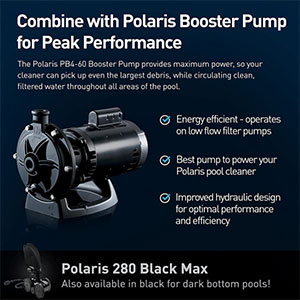
Pressure side pool cleaners are also good, but the problem is that some assembly and installations are required now that they require a separate booster pump. But at least, after the initial installation, the human intervention required is not intensive.
As for the working mechanism, pressure side pool cleaners rely on your pool’s pressure line to suck dirt and debris and for propulsion.
3. Cleaning Performance
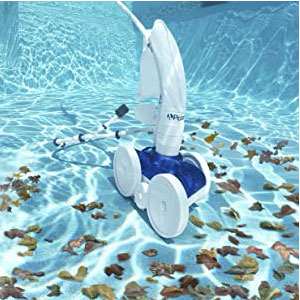
Pressure side pool cleaners, on the other hand, can clean fine, medium, and large debris. However, they don’t guarantee entire-level coverage, especially in irregular and large pools. This is because they lack smart scanning and mapping systems.
Besides missing some spots, they may take longer to clean the pool, around 3 hours. The navigation and maneuverability systems also limit them to the pool floor, walls, and maybe the steps. They can’t clean the tile line.
4. Maintenance
5. Convenience

On the other hand, pressure side pool cleaners are basic automatic pool cleaners with no convenience features such as weekly schedulers or remote operation.
6. Purchase Costs
As for pressure side pool cleaners, they are at least cheaper. Prices start from $200.
Frequently Asked Questions
1. Is a robotic pool cleaner better than a pressure side cleaner?
2. How long do pressure side pool cleaners last?
3. Do robotic pool cleaners really work?
Wrapping Up
There you have it, a robotic vs. pressure side pool cleaner comparison review. So, what’s the best choice? Well, a robotic pool cleaner is the better option as it is a modern pool maintenance solution that leaves you with more time to enjoy the pool. It also comes with fancy features that make pool cleaning a buzz. But you still can’t rule out pressure side pool cleaners as they are cheaper and still get the job done despite their flaws.








